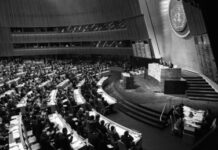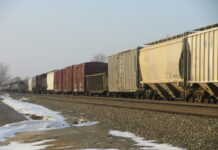Photo Credit: Global Diaspora News (www.GlobalDiasporaNews.com).
In January, North Korean leader Kim Jong-un surprised the world by asserting that the existence of two Koreas – the Democratic People’s Republic of Korea (DPRK) in the north and the Republic of Korea in the south – had in his view become permanent. Kim emphasised that his policy pivot marked the end of nearly 80 years of a relationship that had until then been based upon the inevitability of eventual reunification. Whether or not either side considered that end state inevitable during eight decades characterised by often implacable hostility is debatable. Nonetheless, Kim’s announcement is – on paper at least – a radical policy shift.
Kim first telegraphed the pivot in December 2023, during the annual plenum of the ruling Korean Workers’ Party, an event routinely scrutinised for indicators of Pyongyang’s policy lines for the coming year. On 15 January 2024, the Supreme People’s Assembly – the North Korean legislature – rubber-stamped the announced changes. By Kim’s orders, the Monument to the Three Charters for National Reunification – a visual symbol of the peaceful reunification dream his father built on the outskirts of Pyongyang – was demolished by the end of January. Furthermore, a raft of websites hitherto run by the United Front Department – the North Korean government agency dealing with inter-Korean relations – have gone dark. In due course, the constitution is set to be amended.
These developments come at a time when North Korea has been flexing its military muscle. Although Pyongyang has eschewed nuclear testing since 2017, it has been building up its missile and satellite launch programs at a rapid pace, especially since the autumn of 2021. It has promised multiple satellite launches utilising ballistic missile technology in 2024, and in his Assembly speech, Kim called for an ambitious program of military modernisation. The North is also set to block all channels of inter-Korean communication, as well as to physically plug road and rail links between the two Koreas, links that the North Korean military has long seen as a troubling weakness at the country’s southern border. Finally, Kim warned in vague terms that Pyongyang could seek to redefine the territorial sphere where North Korea asserts sovereignty, notably in the long-contested West Sea.
None of the above means that war in the Korean peninsula is impending, much less that South Korea itself is immediately at risk. Arguably, Kim’s change of policy reduces existing conflict risks since it removes the spectre of forcible reunification, at least notionally. But it simultaneously creates new ones, heightening the danger of clashes with South Korea, particularly in what is an election year in both the South and its close ally the United States. To better understand how these considerations balance each other out, it is useful to consider the context in which Kim made his decision.
Kim has framed the change of policy as a response to what he portrays as series of aggressive and provocative actions by South Korea and the U.S., including efforts to institutionalise trilateral U.S.-South Korea-Japan cooperation. Kim took particular offence at Seoul and Washington signing the Washington Declaration in April 2023. This declaration led to the creation of a Nuclear Consultative Group between the two allies. This Group, approximately modelled on nuclear consultations within NATO, calls for the U.S. and South Korea to jointly plan and implement responses to North Korean nuclear use. The Washington Declaration also opened the door to U.S. nuclear-armed submarines repeatedly visiting South Korean ports, a move the U.S. presents as necessary to strengthen deterrence but North Korea regards as provocative. Pyongyang also highlighted the expansion of UN Command, the institutional remainder of the U.S.-led multinational force that fought North Korea and China in the Korean War (1950-1953), into what Kim branded a “multinational war organisation for provoking the second Korean War”.
Kim is largely blaming the deterioration in North-South relations on South Korean President Yoon Suk-yeol.
Kim is largely blaming the deterioration in North-South relations on South Korean President Yoon Suk-yeol, whose conservative government has been in power since mid-2022. According to Pyongyang, Yoon’s support for the U.S.-South Korea alliance and his administration’s hardline anti-communist rhetoric triggered North Korea’s decision to scrap an inter-Korean military agreement in November 2023. An annex to the Pyongyang Declaration that was inked when former South Korean President Moon Jae-in visited the North Korean capital in September 2018, and was designed as a series of simultaneous steps to reduce the degree of inter-Korean border militarisation, the agreement had brought a measure of predictability to military manoeuvring along the unsettled border. By removing several guard posts at sensitive points along the shared frontier, it even provided for a modest degree of de-escalation. Maybe most importantly, it brought greater calm to contested seas west of the peninsula. But as Seoul drew closer to the U.S. under Yoon, North Korea claimed it was making “intentional and provocative moves” that, in effect, rendered the agreement moot. When Seoul formally abrogated part of the agreement in response to a North Korean satellite launch (an action that is forbidden under UN sanctions as a way for the DPRK to perfect its ballistic missile technology, among other goals), the North responded by annulling the agreement in its entirety.
As it recasts its relationship with South Korea, the DPRK has taken aim not just at the current government but also at traditionally more dovish liberals. In a calibrated attack on 3 January, the North Korean leader’s sister, Kim Yo-jong, accused “smart and crafty” former President Moon of also being more committed to the alliance with the U.S. than to inter-Korean relations, even while he was engaging in dialogue with Pyongyang in 2018-2019.
The new inter-Korean policy has several attractions for the North Korean regime. Domestically, by emphasising the threat posed by a hostile South, Kim diverts public attention from the economic challenges posed by his mismanagement of the pandemic: by forcibly shutting down the nation’s borders, he choked off almost all trade, tourism and labour exports, leading not only to widespread shortages of food and other basic goods nationwide, but also to falling incomes for politically important groups in the North Korean capital.
Equally importantly, the new policy undergirds his efforts to control and limit South Korean cultural and political influence in North Korea. For the past 30 years, South Korean pop culture – principally K-pop, soap operas and films – has found its way into North Korea, challenging the regime’s control over information. Pyongyang has tried to stop the flow of such content across its borders, but with only limited success. The coronavirus pandemic offered an opportunity to try again. In halting cross-border trade and diverting funds to harden the country’s border with China via extra fencing, personnel and spotlighting, Kim grabbed an opportunity to curtail Seoul’s cultural influences, which helps preserve the regime’s legitimising narrative and maintain ideological control. Promulgation of the extraordinarily broad DPRK Law on Rejecting Reactionary Ideology and Culture in 2020 (further broadened and strengthened in 2022) reinforced North Korea’s strict isolationist stance during the pandemic years. In this regard, Kim’s new pivot is an institutional reflection of a trend that has been under way for several years.
The international electoral calendar likely plays a role in Kim’s thinking as well. South Koreans go to the polls for legislative elections in April and U.S. voters will elect their next president in November. By cutting off cross-border communications channels and demolishing monuments, North Korea aims to create the sense among the South Korean electorate that Seoul’s conservative administration is driving the peninsula in the direction of war. It may also be trying to press opposition liberals to be less deferential to the U.S. when they next come to power. This gambit is, however, unlikely to sway voters, who have grown indifferent to North Korean tactics of this nature. Kim may also be playing to national security hands in Washington, hoping that by increasing threat perceptions, North Korea may get more attention (and in so doing position itself for assorted political and economic concessions) than has been the case thus far under the administration of President Joe Biden.
Repudiating Kim Il-sung’s vision of a united Korea could raise questions among North Koreans about the fundamental tenets that help bind the country together.
Whatever benefits Kim may hope this pivot brings, it also comes with certain risks, especially domestically. Recent announcements amount to an explicit rejection of a policy position set out by his grandfather Kim Il-sung, the founding leader of North Korea. It is Kim Il-sung’s legacy that serves as the foundation of the Kim family’s political legitimacy. Repudiating Kim Il-sung’s vision of a united Korea could raise questions among North Koreans about the fundamental tenets that help bind the country together under a single ideology. That said, it would be extraordinarily difficult for anyone to act on these questions given how tightly the harshly authoritarian regime controls the country.
Kim’s pivot – which Seoul rightly sees as a repudiation of any effort to warm relations with the South – can only put further into the deep freeze any efforts to diversify the DPRK’s external partners in order to offset its economic over-reliance on China. Since the 1990s, North Korea has attempted to leverage upswings in its relations with South Korea to seek dialogue with – and extract concessions from – the U.S. Kim now denies having any interest in establishing relations with the U.S., and his policy pivot renders such a course much more difficult for the time being. It also means that North Korea has few attractive economic alternatives to Beijing. Pyongyang’s present rapprochement with Russia has its benefits in the military sphere and in the UN Security Council, and the Russian Far East is a promising destination for North Korean migrant labour. Russia, however, is economically too weak to play the role of economic benefactor to North Korea. Pyongyang is thus left with only its enemies – Japan, South Korea and the U.S. – as plausible diversification options if it wishes to distance itself from its overbearing Chinese neighbour. Forging ties with those countries is a tall order to begin with; abandoning any pretence of cordial relations with Seoul only makes such diversification more challenging.
Pyongyang’s new inter-Korean stance should be read in a wider context of global geopolitical developments and realignments, which are working to the regime’s advantage.
U.S.-China strategic competition and Russia’s war in Ukraine mean that all three major powers are less inclined to try putting pressure on North Korea over its wrongdoing, creating space for bold decisions and a reduced risk of backlash. For its part, the U.S. has clearly tried to downplay the DPRK as an issue throughout Biden’s term, presumably because it lacks the stomach for another crisis, much less one it can do little to fix. As for Moscow and Beijing, given their sparring with Washington over Ukraine and Taiwan, among other things, neither seems at all eager to support further punitive measures against Pyongyang in the UN Security Council.
Indeed, at this juncture, neither China nor Russia is inclined to even enforce existing UN sanctions on North Korea. Their respective relationships with Pyongyang seem to be veering toward more cooperation, not less. In honour of the 75th anniversary of bilateral relations, Beijing and Pyongyang have declared 2024 to be China-DPRK Friendship Year, stating they will “further promote exchanges in all fields, including politics, economy and culture”. Meanwhile, Russia is attempting to diminish and maybe eventually eliminate the role of the UN Panel of Experts that collates evidence of North Korean sanctions violations, perhaps not surprisingly given that Russian President Vladimir Putin is not only buying North Korean munitions in bulk for the war in Ukraine, but also supporting North Korea’s satellite program (which in all likelihood means supporting its sanctioned long-range ballistic missile developments, even if only indirectly). In February, Russia became the first country to resume tourism to North Korea, and it may be poised to ramp up trade through the remote North Korean port of Rason. Kim recently received a Russian-made car from Putin as a symbol of the two leaders’ special relationship.
There is little to suggest that the near-term likelihood of war is increasing.
As for whether these changing alignments, and the North’s new posture toward the South, augur greater risks of conflict on the peninsula, there is little to suggest that the near-term likelihood of war is increasing – if only because mutual deterrence is quite strong. But the peninsula’s security crisis hardly seems likely to abate either, even if the North has abandoned forcible reunification as a reason for conflict with the South. After all, Pyongyang’s overarching goals continue to include regime preservation and domination of Korean peninsula politics. Both goals continue to bring the risk of violence, as does the North’s propensity to use aggressive actions against the South to advance domestic political cohesion. These risks are augmented by the lack of cross-border communication and the persistence of activities by each side that the other finds provocative – eg, missile testing by the DPRK and regular military exercises by the U.S. and South Korea.
Over the longer term, trends are worrying. North Korean military developments in particular have the potential to foster significant instability on the peninsula and the wider region. These include the country’s successful testing of solid fuel for its long-range missiles, a technology that affords its arsenal greater speed and flexibility; the production of (still untested) miniaturised nuclear warheads; and the development of multiple independently targetable re-entry vehicles that will greatly complicate allied efforts at missile defence.
As the DPRK’s arsenal grows in sophistication and lethality, so, too, will the attendant risks. These include nuclear and non-nuclear proliferation to state and non-state actors, and even nuclear accidents in impoverished North Korea. Deterrence and containment may be the best tools for managing these risks at present, but over the longer term they will come under increasing strain; a return to diplomacy will at some point become necessary. How that might happen is difficult to imagine, but it is not too early for Washington and Seoul to be quietly thinking through – even at a moment when that prospect seems more frustratingly distant than it has in years.
Source of original article: RSS (www.crisisgroup.org).
The content of this article does not necessarily reflect the views or opinion of Global Diaspora News (www.GlobalDiasporaNews.com).
To submit your press release: (https://www.GlobalDiasporaNews.com/pr).
To advertise on Global Diaspora News: (www.GlobalDiasporaNews.com/ads).
Sign up to Global Diaspora News newsletter (https://www.GlobalDiasporaNews.com/newsletter/) to start receiving updates and opportunities directly in your email inbox for free.






























